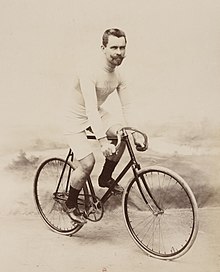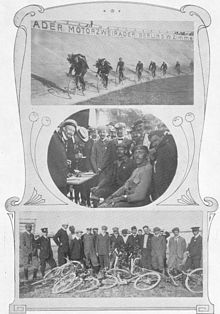Distance bike ride Vienna – Berlin
The distance bike ride from Vienna to Berlin took place from June 29 to June 30, 1893 and covered 582.5 kilometers. It was the most important German and Austrian road race before the First World War and initiated a bicycle boom in these two countries.
Preparations
The reason for the endurance bike ride was the distance ride Berlin – Vienna, Vienna – Berlin 1892 . The planned simultaneous start of cyclists was thwarted by the Prussian War Ministry in Berlin , as they did not want to expose the riding officers to competition from cyclists. Cycling was forbidden by the military and generally in the city of Berlin at that time and was considered an exalted hobby of the wealthy. Thereupon, at the suggestion of the racing cyclist Johannes Pundt, a “Comité” was founded to organize the bike race from Berlin to Vienna the following year; Appeals for donations in the extremely interested press, which viewed the project as a major national event, brought in 6,000 marks in cash and 5,000 marks in value on the German side alone. The race was advertised for "gentlemen drivers" (amateurs) in Germany and Austria-Hungary , the entry fee was ten marks.
Start in Vienna and course of the race
In honor of the distance cyclists, cycling competitions were held in Vienna four days before the start . Receptions, a city tour and a Festkommers were on the program as well as a night parade with several hundred cyclists on decorated and illuminated bikes.
The distance trip itself was started on Thursday, June 29, 1893, at 6 a.m. in Floridsdorf near Vienna in front of 8,000 spectators. 117 drivers were sent off in 15 groups with an interval of five minutes. The later track world champion from 1894 , August Lehr, was the favorite . He is said to have had 16 personal " pacemakers " in the race. Nevertheless, the train driver Lehr had to give up early on this road race because he had tackled it too quickly. At first Georg Sorge from Cologne was in charge , but was later overtaken by Josef Fischer from Munich . Fischer reached Berlin as the winner after 31: 00: 22.4 hours, which meant an average speed of 19 km / h. Bruno Büchner , who later made a name for himself as an aviation pioneer, was tenth with 36 hours and 37 minutes . Participants described the poor road conditions in Austria as the greatest difficulty, where most of the route was "not driven". There were also some heavy thunderstorms at times, which led to a number of tasks.
Full of admiration, the organizing committee wrote under the final checklist that all finalists had to sign: “However, none of all the signatures reveals the enormous strain and tension of the entire nervous system, which required the enormous effort; here the signature proves what human will and human strength can achieve. "
For comparison: the year before, the distance on horseback had been covered in 72 hours. Within a week of the race, 30 horses of the participating riders had died.
Arrival in Berlin

Thousands of spectators welcomed fishermen with shouts of hurray and formed a trellis along the street in Berlin-Tempelhof . Second was Sorge, who also stayed under 32 hours; the next four drivers needed more than 34 hours. Only 38 drivers reached the destination within the waiting period of 50 hours. Heavy thunderstorms had raged during the night, many had given up, some even got lost. The winner Josef Fischer was honored with a Thaler tankard worth 800 marks, a gold medal and a case of Rhine wine.
In Berlin, too, a festival program was organized to welcome the racing drivers, with a parade and races on the Halensee track .
organization
The racing cyclists received maps, route descriptions and papers for crossing the border from the “Comité”. The essential information was summarized in a logbook. The control signatures were also made in it. The logbook of the participant Oskar Jander from Dresden was preserved and was in the possession of the former Chemnitz racing driver Werner Richter for a long time . It was published in parts in a book. 300 checkpoints were manned along the route. The passage of the participants was reported by telegram, two chronometers were used for the timekeeping, one of which was brought to Berlin by express train.
Known participants
Effects
Since the 1870s, bicycles and horses have been in competition with each other as individual means of transport. That is why at that time there were often sporting comparisons between cyclists and riders. Pure bike races, on the other hand, initially had the primary purpose of demonstrating the capabilities of bicycles. The question of which make won a race was also of great importance. A number of bicycle and tire manufacturers - including Adam Opel , Continental and Michelin - had donated material prizes for the long-distance journey. In addition, two of Opel's sons took part in the parade in Vienna. After the distance ride, advertisements for the most successful bicycle brands appeared.
The distance bike ride Vienna-Berlin had proven that you were faster on a bike than on a horse. In addition, the bicycle had proven its suitability as an indestructible travel companion. In the following years, bicycle production boomed in Germany and Austria, which can be attributed to the journalistic effects of long-distance travel, but also to the introduction of the first pneumatic tires in 1892. The runner-up from “Vienna-Berlin”, Georg Sorge, founded the Allright bicycle factory in Cologne .
The success of the distance race, the organizers of which were also inspired by the French cycling races Bordeaux – Paris and Paris – Brest – Paris , marked the beginning of road cycling in Germany: a significant increase in road races, growing press coverage and a growing number of road racers. Five times - in 1908 (winner: Hans Ludwig ), 1911 ( Hans Hartmann ), 1912 ( Franz Suter ), 1913 ( Paul Thiel ) and 1914 ( Erich Aberger ) - the race was held again.
literature
- Rüdiger Rabenstein: The distance bike ride Vienna - Berlin 1893. Impulses - influences - controversies. In: Social and Contemporary History of Sports , 10th year, issue 1/1996, pp. 42–56.
- National production in Germany: The distance journey Vienna-Berlin 1893 . In: Anne-Katrin Ebert, Cycling Nations: The History of the Bicycle in Germany and the Netherlands up to 1940: Cycling as a National Movement: “Invented Traditions” and productions. Campus-Verlag, 2010, p. 192 ff. ISBN 9783593391588 .
- Sales of military cyclists on distance cycling Vienna – Berlin. In: Best's practical handbook for cyclists and those who want to become one , p. 27 f, Stettin 1895.
Web links
- The distance ride Vienna - Berlin 1893 on cycling4fans.de
- Cyclist map Vienna – Berlin, 1: 250 000, lithograph, approx. 1908, 1 ct. In leporello form: multicolored. ; 213 × 9 cm, folded. - With height profile and symbols - Consists of 5 sections (digitized)
Individual evidence
- ↑ XV. Peace ride . In: New Germany . Berlin 1962, p. 18 (quoted from: Zeitschrift für Alle. Berlin. 1894).
- ↑ Review of the distance bike ride Vienna-Berlin 1893. Published by the Comité Berlin. Based on : Kurt Graunke , Walter Lemke, Wolfgang Rupprecht: Giants from then to now: The history of German professional road cyclists . Munich 1993, p. 237.
- ^ Kurt Graunke, Walter Lemke, Wolfgang Rupprecht: Giants from then and now . Edition Sedina, Munich 1993, ISBN 3-9803273-0-2 , p. 231-237 .


